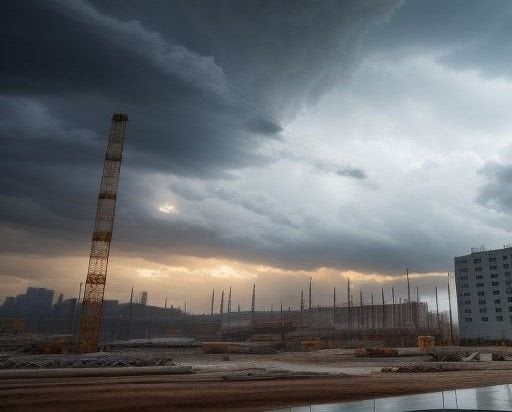Climate change refers to changes in weather patterns that fundamentally affect the world both regionally and on a global scale. Throughout history, such changes have taken place naturally, sometimes due to cataclysmic events such as meteor impacts on the surface of the Earth.

Terena Chetty, Head of Strategy at 1Africa Consulting
However, the climatic changes faced in recent times are largely driven by human behaviour, including deforestation and the ongoing release of pollutive greenhouse emissions through the widescale burning of fossil fuels. This has impacted the natural functioning of the planet. As a result, we are faced with a myriad of environmental issues, including unprecedented changes in heat and weather patterns.
The effects of climate change are vast, and the worry is that we are not addressing the issue as vigorously and swiftly as we should. A major cause for concern is the subject of employee health and safety.
Are we being proactive enough in tackling current safety issues, as well as taking preventative measures based on predictive forecasts of an undeniably worsening situation?
Key climate change impacts include:
- Rising temperatures: According to the National Aeronautics and Space Administration (NASA), there is unequivocal evidence that Earth is warming at an unprecedented rate. The Earth’s average surface temperature in 2023 was the warmest on record since record-keeping began in 1880. This increases the prevalence of heat waves and the intensity of solar UV radiation reaching Earth.
- Extreme weather conditions: Extreme weather conditions resulting from climate change include severe storms, higher incidences and scales of flooding, drought, cyclones and hurricanes; and a multitude of other small and large weather-related disasters.
- Health risks: “Climate change is the single biggest health threat facing humanity” – the United Nations (UN). Widescale air pollution, the contamination of oceans and rivers, extreme weather conditions and other environmental factors are affecting health and wellness on a global scale. Healthcare systems are struggling to keep up with the changing and escalating situation.
Jabulile Mbatha 11 Mar 2024 Effect of climate change on occupational health and safety
Are we being proactive in ensuring that occupational health and safety (OHS) measures take climate change into consideration? Below are some questions facing the health and safety industry:
- Personal protective equipment (PPE): Have PPE items evolved in line with changing weather conditions? For example, are UV protective glasses still providing adequate protection in light of increased UV exposure? Does clothing issued to outdoor workers provide protection from long-term sun-exposure-related illnesses, such as skin cancer?
- Mechanical & heavy-duty equipment: Equipment such as cranes, scaffolding, construction vehicles and mechanical devices are often exposed to the sun for long periods. According to the World Construction Today platform: sun exposure can weaken plastic components in heavy-duty equipment, a high concentration of heat can cause equipment parts (such as electrical components) to melt or malfunction and hot weather accompanied by dryness could cause static electricity build-up that results in errant discharges in equipment. While such equipment may have safety measures and procedures in place, are these still adequate for current and future environmental changes?
- Training: Ongoing training is crucial for occupational health and safety, and requires continual upskilling and refresher courses. Climate change factors need to be highlighted as part of training curriculums. These include highlighting the dangers of non-adherence to protocols – for instance, explaining the perceived “harmless” act of removing protective PPE outdoors could result in exposure to UV radiation and an increased risk of skin cancer.
- Forecasts and preventative action: Are companies doing enough when it comes to analysing predictive data and taking preventative measures? For example, the possibilities of floods, structural damages due to inclement weather conditions, the necessity for more frequent and thorough maintenance exercises and so forth.
Being proactive can mean the difference between life and death for workers, as well as communities, and it is the responsibility of companies to do their utmost to prevent workplace-related illnesses and injuries.
As explained by Kate Collier, specialist OHS lawyer and partner at legal firm, Webber Wentzel:
The growing understanding and recognition of the importance of Environmental, Social and Corporate Governance (ESG) in the manner in which employers manage their impact on employees and communities highlight that ensuring employees are safe while at work, and not exposed to a risk of disease, is more than a mere legal compliance imperative. It is a core component of sustainability, of responsible corporate citizenry, and a necessary practical example of a company truly recognising and protecting the human rights of its workers.
As a means to highlight the urgency of mobilising solutions to address the effects of climate change on workplace health and safety, the theme of this year’s World Day for Safety and Health at Work is: The Impacts Of Climate Change On Occupational Safety And Health.
Driven by the International Labour Organization (ILO), the World Day for Safety and Health at Work takes place on 28 April each year.
Manal Azzi, ILO OSH team lead, emphasises the need for swift action: “Worldwide, climate change is already having serious impacts on the safety and health of workers. Flooding and hurricanes, excessive heat and UV radiation exposure are leading to a rise in work-related diseases and injuries. We can act now to prevent further harm.”

Image: Supplied
Speaking on the issue, Sanjay Munnoo, chief business development officer at the Federated Employers Mutual Assurance Company (FEM) and President of the South African Institute of Occupational Safety and Health (SAIOSH) said, “Climate change is expected to get worse, and the workforce needs to be prepared with initiatives aimed at educating them on the impact climate change can have on their health. Vulnerable employees, particularly, require proper guidance and advice on risk mitigation.”
As environmental issues intensify, urgent steps must be taken to prevent increases in work-related illnesses and injuries resulting from rapidly changing weather patterns. The consequential impacts of climate change are unavoidable – practical and effective solutions are needed now.











































